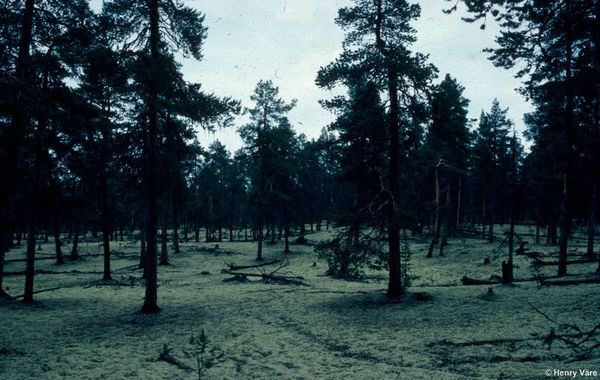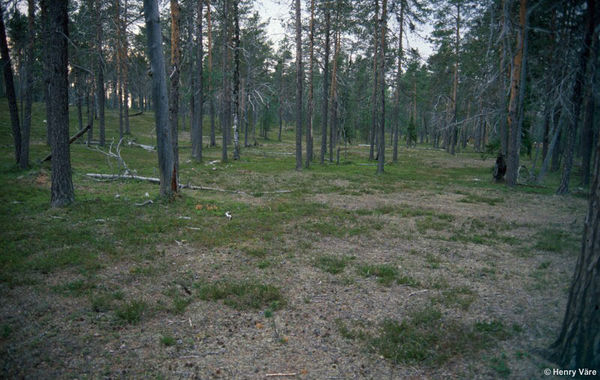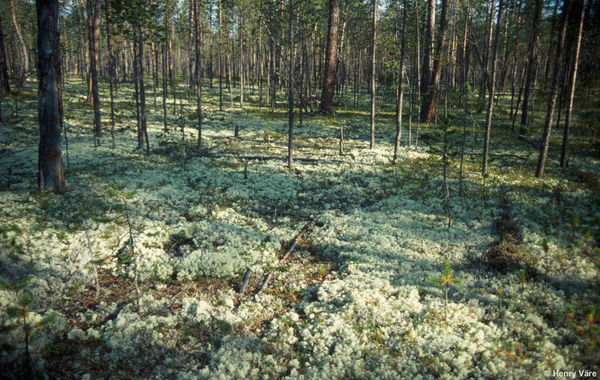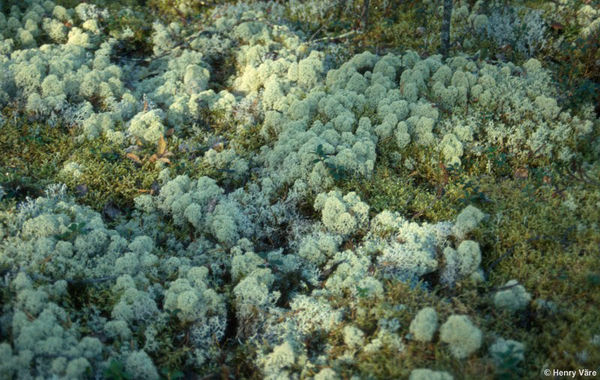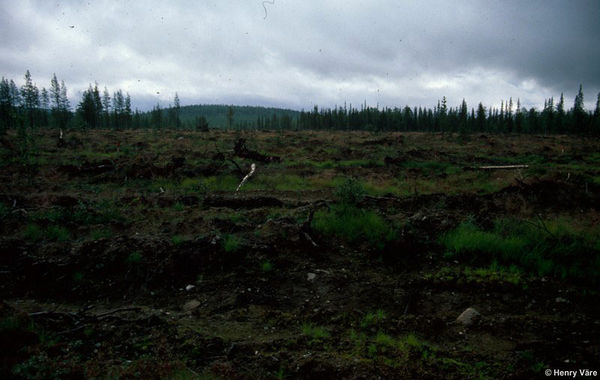Paimennus
Paimennus
Herding
Herding semi-domestic reindeer has been very important both economically and socially for the people of northern Fennoscandia. The annual activities of the herdsmen and their families were dictated by the rhythm of nature as families were dependent on the reindeer for their livelihood. Although the old pastoral way of life has ceased, nature still dictates the life of those whose livelihood is dependent mainly on reindeer herding.
Today the number of fulltime herders, who together with their families still obtain their main livelihood from reindeer herding, is about 800 in Finland. Most of them are Saamis. Depending on the definition of the name, there are about 5000 Saamis living in Finland today. About 600 of them are reindeer herders. The number of reindeer owners is about 6700. In Finland anyone living within the area of reindeer husbandry has the right to own reindeer, in contrast to the situation in Norway and Sweden, where only Saamis are legally permitted to keep reindeer. The vast majority of owners practise reindeer husbandry as a supplement to agriculture and forestry. With regard to ethnic groups in Finland, reindeer herding is from the economic point of view relatively most important for Saami people.
The annual total revenue from reindeer husbandry in Finland is estimated to be 60 million euros. The main product is meat. In 1999-2000, 93000 reindeer were slaughtered, producing 2.1 million kilos of meat. In addition to meat production, reindeer are also an extremely valuable resource for both summer and winter tourism, as they are one of the main attractions for foreign tourists.
The total of reindeer husbandry area in Fennoskandia is 423000 sq. km., and it is located in the north. In Finland the area is 123000 sq. km, constituting one third of the total surface area of the country. It is divided into fourteen different earmark districts, and 56 herding cooperatives (paliskunta in Finnish). The responsibility of the cooperatives is to protect the reindeer stock, to sustain and promote reindeer husbandry and to prevent reindeer from causing damage and from trespassing on the territories of other cooperatives. Reindeer husbandry is under the jurisdiction of the Ministry of Agriculture and Forestry in Finland. In Norway and Sweden, it is the responsibility of State Departments of Agriculture. In Finland the semi-official administrative board of the herding cooperatives (Paliskuntain yhdistys) has sixteen members. It organizes the annual Reindeer Parliament at the beginning of June. The duties of the organisation are to administer reindeer husbandry in Finland, to promote reindeer husbandry and related research, and to manage relations between reindeer husbandry and the rest of society. It also approves new reindeer earmarks and maintains a register of them. The office is located in Rovaniemi in northern Finland, and it publishes a journal for reindeer herders named Poromies. In Norway there is a corresponding journal called Rangifer.
The semi-domestic reindeer (Rangifer tarandus tarandus) was most probably bred from its ancestor, the wild mountain reindeer (R. tarandus fennicus), but when and where reindeer herding started remain open questions. According to one theory, reindeer herding first started in Siberia, and it then spread to the Saami areas. Another explanation suggests that the Saami discovered the domestication of reindeer themselves independently of reindeer husbandry in Siberia.
A considerable proportion of the present Finnish semi-domestic reindeer population lives outside the range of the wild mountain reindeer. In Finland, the latter is restricted to a small area in the north-eastern part of the country. The size of the wild mountain reindeer population increased during 1990s, but the population and home range area is still very small compared to those of the semi-domestic reindeer. The Rangifer genus, which includes both Eurasian reindeer and North-American caribou, inhabits the circumpolar northern boreal zone (flora) and Arctic areas. It is calculated that the total number of reindeer is about 3 million individuals.
It has been estimated that reindeer herding in Fennoscandia is about 2000 years old. According to archaeological finds, reindeer herding may have appeared simultaneously with deer hunting. The emergence of reindeer husbandry as a source of livelihood probably began in central Norway in the eleventh century. Large-scale herding then spread to the east. The total population of reindeer in the fourteenth and fifteenth centuries in central Lapland was quite small compared with that of eastern areas of Lapland and westernmost Norwegian and Swedish Lapland in those days. However, there is little historical information about reindeer populations in Fennoscandia until the sixteenth century. Undoubtedly, the reindeer already moved between summer and winter ranges during early era of herding, and the numbers of reindeer were obviously determined naturally by winter range resources, mainly by the availability of reindeer lichens. A similar behavioural pattern has also been suggested for the caribou in North America. In the sixteenth century, Finnish, Norwegian, Russian and Swedish peoples penetrated the last frontiers of territory originally inhabited by the Saami. Since then, the policies of the dominant powers have played an increasing role in determining the numbers of reindeer in the area.
In 1751 the northern border between Sweden (which then included Finland) and Denmark (which included Norway) was negotiated. The reindeer Lapps were permitted to cross the border, and as a consequence the Saami of what today is Norway also began to use winter ranges in present-day Finland, in both the Enontekiö and Inari areas, and even further south in the Karesuando area in Sweden. This resulted in increased reindeer populations in these regions. As a consequence, Finnish reindeer-herding Lapps began to complain about overgrazing. The situation finally changed when the borders of Finland were closed to reindeer-herding Lapps in 1852 by the Finnish-Russian authorities - in 1809 Finland had been separated from Sweden and united with Russia, although this was obviously not so important to the reindeer Lapps since the Russian authorities were hardly interested in their traditional migratory patterns. The border between the Grand Duchy of Finland and Sweden was finally closed to the reindeer Lapps in 1889. The border between Norway and Sweden, too, was progressively closed to reindeer in the twentieth century. Thereafter, reindeer herding was obliged to live with unnatural borders closing the routes between summer and winter ranges. As a result, the number of reindeer decreased, especially in eastern Finnmark, as about 50,000 reindeer had their winter ranges in the Inari and Utsjoki areas. In Finland, the number of reindeer owned by reindeer-herding Lapps did not change. Since at least some of the summer ranges had previously been situated in coastal Norway, and the winter ranges were in Finland, the Finnish pastures now had to be used all year round. The closure of the border affected above all the reindeer-herding Lapps of the Utsjoki area.
At the beginning of the twentieth century, the number of reindeer in Finland was slightly over 100,000, and by 1959-60 it had reached 140,000. Short-term fluctuations in the reindeer stock have occurred over the century. During the 1970s and 1980s the number increased rapidly and reached 285,000. This was considerably in excess of the highest permitted number in those days. It was made possible by winter feeding, vaccines and a decrease in the number of predators (especially the bear, the glutton, the wolf and the golden eagle) and the use of motorised vehicles for herding. Reindeer husbandry today is thus a livelihood that uses modern technology. Some traditional features of nomadic reindeer herding have, however, survived, especially in the northernmost reindeer-herding cooperatives.
In the Kola Peninsula of Russia, reindeer herding has a roughly similar early history to that in Finland. Later, during the 1930s and 1940s, large areas in the western parts were evacuated as a result of Stalin's policy, and in consequence the reindeer stock decreased. At the beginning of the 1940s, there were about 9000 reindeer in the Lapland Nature Reserve, in the 1960s there were 14,000, but recently only 500-600. Today there are plans to increase the population again. In total, there are about 40,000 reindeer in the Kola Peninsula, mainly in the central and eastern areas, with some 2000 animals in the Pechenga area close to Finland and Norway. The number of reindeer has increased in northernmost Norway from 53,000 in 1950 to 180,840 in 1990. The population density in the more extreme areas of the winter ranges of Finnmark, which neighbours Finland, is, however, less than one animal per square kilometre. The areas bordering northern Finland support a considerably lower number of reindeer.
Due to the development of herding practices and the increase in the reindeer population, the pastures in Finland today are heavily grazed. Over vast areas, the number of reindeer has exceeded the productivity of lichens in the winter pastures. This is a major problem that currently awaits a solution. Reindeer are dependent on lichens only during the winter, especially late winter, when other sources of food are scarce. In seasons when the ground is not covered with snow, they eat a variety of plants, and in autumn fungi are also an important source of nourishment. The bad pasturage conditions are evidenced by the fact that the slaughter weight of calves has decreased in areas where the winter ranges are most heavily exploited. Consequently, the reindeer have to be fed with hay or imported lichen during the winter. This practice started in 1974, and it is the most significant single contributory factor to maintaining the present high number of reindeer. The maximum number of reindeer was consequently lowered from a previous 220,900 animals to 203,700 over the current ten-year period. This means 1.8 animals per square kilometre on average, but naturally the herds are not evenly dispersed. As a result, however, the pastures in the other Nordic Countries and in the Kola Peninsula are now in a better condition.
In the Nordic countries, an understorey rich in lichens is found ondry oligotrophic sandy soils, usually under a pine canopy.
It is particularly such forests that are heavily grazed by reindeer.
As forest fires are now controlled, the trampling and grazing of lichens by reindeer is today a major factor regulating the vegetation cover, and it has led to a significant alteration in the plant cover of the forest floor in Finland. In the first Finnish national forest inventory (1921-24), the lichen-rich Cladonia forest type accounted for about 12% of the forested land, but in the third inventory (1951-53) for only 1%.
Remote sensing has revealed a sparse lichen cover in birch and pine forests and on treeless heaths over large areas of eastern and northern Finland. The line of Finnish-Russian border, or more precisely of the reindeer fence that follows the border, can be clearly distinguished in a satellite composite image. This is due to the higher number of reindeer in Finland. The main consequence of grazing for the vegetation is a reduction in lichens and an increase in bryophytes and bare patches of soil. Reindeer lichens in particular are replaced by other lichen species and by bryophytes like Dicarnum spp. and Pleurozium schreberi. The recovery of the lichens is very slow; in northern latitudes it takes over fifty years before it reaches the climax stage of the forests, and the forest floor is again dominated by Cladina stellaris.
The most important and most challenging task today is to find a way to integrate diverse interests regarding reindeer pastures. In order to maintain a vigorous reindeer husbandry, it is necessary to resolve the problem of both the quality and the sufficiency of the pastures. An extensive proportion of the reindeer-herding area consists of coniferous woodland, and it is thus commercially exploited by forestry. These two sources of livelihood are often in conflict, as efficiency demands like extensive clearing and ploughing of the soil for conifer seedling recruitment, which tend to lower the quality of the pastures.
Other conflicts are caused by the mining industry and increasing tourism, especially in areas that are important for calving. The third major problem is the question of legal ownership of the pastures in the reindeer-herding area. Currently these are owned by the state, but there are dissenting opinions which are waiting to be addressed. A fourth problem is the conflict between nature conservation and reindeer herding. The reindeer is an important source of food for the big predators, mainly the glutton, bear, wolf and golden eagle. In 1997, about 3,400 reindeer were found killed, mainly by these big predators. The latter are endangered species, but they cause the herders economic losses, and thus they are often illegally hunted and killed. The fifth major problem is perhaps the greatest. The age distribution of the herdsmen is very biased towards the older classes, and there are too few young persons continuing their work. Thus the problems concern matters that are socio-economic and political in origin and natural resources. Durable development requires stable herding conditions. The main task is therefore to develop a system of optimal usage which will permit the ranges to be adapted for various purposes and still maintain the economy of reindeer herding as an important goal.
Table of contents: Means of livelyhood and transport
